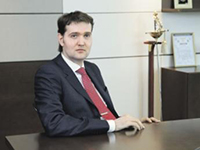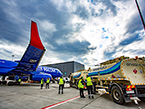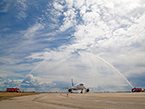
Aviation refueling operator does not have to be a part of a major oil company to offer best prices to air carriers. Aerofuels, the private operator, has proved that. For 18 years, the company has grown from one refueler at Ulan-Ude airport into a refueling service provider at more than 1,000 airports worldwide. VLADIMIR SPIRIDONOV, the Director General of Aerofuels told SERGEY STARIKOV, RBC Daily reporter about the most convenient country to work in, market prospects, and the brand new kerosene.
— A few years ago I heard that foreign airlines preferred to buy Russian fuel for future use and tanker it.
— The price of fuel in the Russian market is 10-15% lower as compared to Europe. Airlines are fighting for every penny trying to catch the lowest price. If Russian oil companies raise the price, then yes, airlines take more fuel in their departure points to buy less in Russia. To respond within a day, the airlines use sophisticated software to figure out if the most profitable refueling is in departure or arrival point.
— Why is fuel so expensive in Europe? After all, they have no excise duty and corruption?
— Historically, kerosene is more expensive in Europe than in Russia. Another 10-12 years ago, the difference was much higher. In 1999, fuel at European airports cost $300 per ton, while in Russia the price was only $100-120. That was the prime-time for Russian airlines. Another thing, our carriers flew Tu-154, Il-86, Il-62, which had poor fuel efficiency as compared to their Western counterparts. Nowadays, domestic airlines fly Boeing and Airbus, and the price difference reduced to 5-15%. However, it does not persist all the time, because sometimes crisis happen to be. In 2011 Moscow lacked kerosene, and within three days prices leapt to $200 per ton, and the price of fuel in Moscow exceeded European by $150.
— The cost of fuel in regions is still higher than it is in Moscow…
— We cannot talk about all of the regions. Some airports, such as Irkutsk, have alternative refuelers. There the price per a plane is 13% lower than in Moscow. We calculated that Russian airlines saved more than a billion rubles within four years of our work in Irkutsk. But some airports have created unique situations. The government backs carriage of certain groups of passengers, and the airlines give this money to monopoly fuelers that sell fuel at a higher price. In fact, the government allocates budget funds to these fuelers. It is now happening in Khabarovsk and Yuzhno-Sakhalinsk.
— Why don’t they have alternative refuelers?
— As for Yuzhno-Sakhalinsk, Aerofuels is now working on the creation of alternative refueling facility. I hope it will start in 2013. However, we can do nothing for Khabarovsk so far…
— What do you mean? They don’t invite you or the airport authorities don’t want anyone to be into that business?
— In general, the situation in regions is improving. But it is slow. Executives are hard to realize that it is impossible to develop an airport hub without creating suitable conditions for airlines servicing; and the price of fuel is an important condition. 96% of European and US airports have 2 – 8 fuel supply operators. Speaking of Russia, only 14 airports have several operating refuelers, ten of which are owned by Aerofuels. For example, Pulkovo consumes 420 tons of fuel per year. This is a large amount by European standards, and there would be 4 operators, each of them having profit and margin.
Creating a regional airport infrastructure and building a new refueling facility takes more than one year. I’ll give you an example. A few years ago we were talking with Aviation Fuel Services, our Germany partners, who fill about 5 million tons per a plane in 11 German airports; that is five times more than we do in Russia. I asked how much time they spend to agree on a refueling facility draft and start construction. They said, “You know, Germany is very bureaucratic. We spent two months to start the construction at Hamburg airport." After that, one of the German directors asked me, “How much time does it take in Russia?” I replied evasively, since the collection of documents alone takes about two years. In addition to standard agreements in a number of regions, we test drafts on seismic resistance, snow load, and two other airports asked for an archeological research.
— Did you find anything?
— Unfortunately, not a single mammoth. But archaeological examination took about two months. Given the short construction season in Russia, this can delay the commissioning of the facility for a year. It is impossible to build a refueler for one construction season in the middle zone of Russia.
— Do you still have disputes with Tolmachyovo airport authorities?
— Up to date, we do not refuel Tolmachyovo, although we already started operating in four to five new airports. Their management position gets in the way, as it does not coordinate interaction between the airport and alternative fueling facilities.
— Why don’t you operate in Sochi and Krasnodar?
— One cannot have everything. We are completing a few significant projects now. In January, we started filling in Pulkovo, the third largest Russian airport, where our joint venture with Shell will operate. Shell & Aerofuels already provide service to Turkish Airlines, AirFrance and British Airlines. Earlier the airport was considered the biggest monopoly in Europe in fuel supply. We also build a refueling facility in Nizhny Novgorod. Last year we launched Kursk, and plan to start in Kirov. Pay attention to the majority of flights at Sochi airport. Typically, the planes fly out of Moscow, St. Petersburg, Volga region and Siberia. Often airlines prefer to refuel at departure points, where they have a discount for kerosene.
— According to Rosaviation certification, Shell Aerofuels operates inadequate refueler at Domodedovo airport…
— We only provide aviation fuel and store kerosene in airport tanks. Technically, Domodedovo lacks tanks to provide all the airport needs in kerosene storage. On the other hand, they offer us acceptable storage conditions.
— Why do you expand your business in partnership with Shell? How do you share profit and responsibilities?
— Our Group implements 80% of all the projects all by itself. At a certain stage of the development of our company we realized the need to attract the Western competence. Shell is the leading operator, which has been on the market since 1909 and fills every sixth ton of kerosene in the world. In our joint venture profits are divided according to the share of participation. We have it as 50/50.
— What regions is Shell Aerofuels planning to cover in the near future?
— We are considering the Volga region and the European part of Russia.
— How much does it cost to build a refueling facility?
— This is a good question. Construction of a refueling facility is not about commerce but creativity. This is such a unique undertaking there is no standard model of construction and commissioning. In 1999 we developed a typical refueler project, and it never worked out, because airports differ a lot from each other. In terms of capital investments, I guess the price is not less than $5 mln. However, there is a Russian vertically integrated oil company that spent $125 mln to construct its refueling facility.
— Where do you get funds for the construction?
— This is always a symbiosis of proprietary and borrowed funds. Our debt load is equivalent to 4% of annual turnover. We safely survived the crisis of 2008-2009 years, and are fast growing at international airports. Over the past 2-3 years we have started to fill international airlines in Latin America, China and Africa.
— So you were allowed to enter China market?
— Yes, as traders. What is interesting, Asian markets feel safe. Indian market grew by at least 17% every 5-7 years.
— Is it easy to work abroad? Or is it more difficult?
— In terms of business accessibility working abroad is easy, as Europe and America have clear legislative frameworks. But, on the other hand, it is more efficient to operate in the markets with sharp dynamics. Such regions, on one side, provide additional margin, but there are significant risks to build refueling facilities in countries with unstable economies.
— Have you ever considered building a refueling facility abroad, where your property is unexposed to political risks?
— We have such plans, however, this demands a new brand level of the company. This is going to be a direct competition with transnational oil companies. We are on firm ground as international traders. In half an hour we fill any our client, whether it is Russian or international airline at a thousand airports worldwide. We have already bought kerosene, which is registered to our company.
— How much fuel do you have all over the world?
— About 100 thousand tons. We have developed a formula that is profitable to oil companies and is not expensive to us. Oil companies work to sell kerosene and unload their refineries. We make it possible. By the way, European refineries are separated from aviation fuel supply. Competition laws oblige refineries to sell kerosene in the open market. It is often the case that a subsidiary, i.e. the refueling facility operator buys the “outsider” kerosene. And it is the opposite in Russia. Everyone is trying to build a well-to-plane chain, thus preventing competition.
— Aren’t manufacturing companies afraid to sell you fuel as you are competing with their subsidiary airport structures?
— Kerosene is one of the most highly profitable products for oil companies. In Russian aviation kerosene is not subject to excise duties, while diesel fuel excise tax in 2013 makes 4,900 to 5,800 rubles per ton. Kerosene and diesel fractions are close to each other, so sometimes oil companies convert diesel into kerosene fraction.
— Then why is the price for kerosene so high?
— I think the price is high because the demand for aviation kerosene is growing fast. Last year passenger traffic grew by 15%. Demand creates offer and heats the price.
— And what is your return?
— Return on a refueler is not that high and is much less if compared to oil companies. At most airports we operate as alternative refuelers, therefore, we do not gain benefit on monopolistically high price for kerosene. However, these funds allow us to keep developing fast.
— How do you deliver fuel to the refueling facility?
— By railway transport to the airport. In Ufa there is a branch coming from Transnefteproduct pipeline.
— Have you noticed restrictions on fuel supply to Sheremetyevo airport because of the workload at Lobnya station?
— This problem in Sheremetyevo is quite acute. The Transnefteproduct pipeline is operating 100%, but it was built from 1974 to 1981. Moscow aviation hub should have integrated development and solutions for all infrastructure and logistical problems. The problem is that Moscow airports receive transit passengers who do not even have to fly through Moscow. Some time ago Gazprom Neft tried to lay new railway lines. But the requirements of Russian Railways were so strict that even this big company could not solve the problem.
— Have the Custom Union regulation affected your work?
— Nothing has changed in particular. Now they talk amendments to it. One of them is to include RT kerosene in addition to kerosene TC1 and Jet-1 (the western equivalent), which are already on the list. This type of kerosene is produced at several refineries in Russia. There was a problem that the refinery could supply the product corresponding to these Customs regulations but without a certificate to a particular batch. Now they plan to oblige refineries to complete each batch of kerosene, coming from Russian, Belarusian and Kazakhstanian refineries, with a certificate.
— You were planning to bring fuel from abroad, and even bought a tanker…
— We are the only fueling company in Russia that has marine fleet. Aerofuels-Kamchatka employs over 50 sailors. The tanker runs from Nakhodka to Sakhalin and Kamchatka on schedule. In January 2012 our company launched a refueling facility on Kunashir Island at Mendeleevo airport, which is our closest point to Japan, 10 km.
— And what about the plans to produce your own fuel?
— We have no plans to produce our own kerosene yet. I happened to participate in the opening of the largest plant for the production of fuel on the so-called GTL-technology, which is the production of liquid petroleum gas. This is a brand new technology invested with tens of billions of dollars. This kerosene does not smoke because it contains neither sulfur, aromatics, nor resins. Moreover, it is 7% lighter than conventional kerosene. Imagine an airline that runs 100 tons of fuel instead of 93. The combustion of such kerosene is 10-12% more efficient. Globally, successful companies will be the companies that not only use the familiar technologies but also go ahead and invest tens of billions of dollars in new developments unknown to the market at the moment. So simple processing will have no effect.













 News
News 





